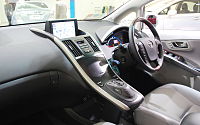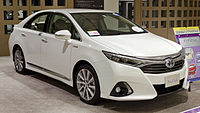Toyota Sai
- Toyota Avensis (T270)
- Lexus HS
- 110 kW (148 hp; 150 PS) (petrol engine)
- 140 kW (188 hp; 190 PS) (combined system output)
The Toyota Sai is a hybrid electric car sharing the same platform and hybrid drivetrain as the Lexus HS. It was launched in Japan on October 20, 2009,[2] following the launch of the Lexus HS in January of the same year.[3] Toyota received about 14,000 orders in one month after its introduction, and the Sai is available at all Toyota Japanese dealership sales channels.[4]
The Sai was released in December 2009 as Toyota's second hybrid-only line after the Prius as Toyota brand model. Positioned between the Prius and the Crown Hybrid, the Sai came in a semi-fastback 4-door sedan body with a trunk. It was a sister car of the Lexus HS 250h that was released earlier in July, and the two models shared the basic components although they were differentiated by their interior and exterior designs. The Sai's body length, width, and height were smaller than those of the Lexus HS 250h by 95 mm (3.7 in), 15 mm (0.59 in), and 10 mm (0.39 in), respectively.
The highly aerodynamic body design extended even to the flat and smooth underfloor covers, attaining a drag coefficient of 0.27 which was among the best in its class. Although the Sai employed the Toyota Hybrid System (THS) II with a reduction gear mechanism (the same as that of the Prius), its engine was a more powerful 2.4-liter unit (2AZ-FXE) producing 150 PS, to which a 143 PS motor was combined to drive the front wheels. The fuel consumption was 23.0 km/L under the 10-15 test cycle.
The name comes from the Japanese word "sai" -which means "talent" and "coloration" when written with the Kanji character.[5]
On June 25, 2010, Lexus (Toyota) recalled 17,801 2010 model year HS250h and Sai models for failing to comply with US FMVSS 301, "Fuel System Integrity", due to the risk of excessive fuel leakage in the event of a rear-end collision. A recall for reprogramming the brake software was issued in February 2010.
On November 15, 2017, the Sai was discontinued and replaced by the Lexus ES 300h, which was released in Japan on October 24, 2018.[citation needed]
Gallery
Pre-facelift
- Front view
- Rear view
-
 Interior
Interior
2013 facelift
-
 Front view
Front view -
 Rear view
Rear view -
 Interior
Interior
References
- ^ a b "Affiliates (Toyota wholly-owned subsidiaries)-Toyota Motor Kyushu, Inc". Toyota Motor Corporation. 2012. Retrieved February 14, 2014.
- ^ Greimel, Hans (September 30, 2009). "Toyota is adding another hybrid sedan--the Sai--for the Japanese market". Autoweek. Retrieved February 7, 2014.
- ^ Hardigree, Matt (January 11, 2009). "Lexus HS 250h: A Prius For The Country Club". Jalopnik. Retrieved June 22, 2012.
- ^ "Toyota Receives About 14,000 Orders for the Sai in One Month". Green Car Congress. November 24, 2009. Retrieved February 7, 2014.
- ^ "75 Years of Toyota - Vehicle Lineage - In-depth Vehicle Information, Specification - Sai". Toyota. 2012. Retrieved June 4, 2022.
External links

- Official website (in Japanese)[dead link]
- v
- t
- e
| Current | |
|---|---|
| Former |
| Asia-Pacific | |
|---|---|
| Africa | |
| Americas | |
| Europe |
|
| Global | |
| Defunct |
- Subaru (20%)
- Mitsubishi Aircraft (10%)
- Mazda (5%)
- Suzuki (4.9%)
| Current |
|
|---|---|
| Defunct |
| Kei cars | |
|---|---|
| Cars | |
| Pickup trucks/Utilities |
|
| SUVs/Crossovers |
|
| Minivans/Vans | |
| Commercial trucks | |
| Buses |
models
- 1000
- 1900
- 2000
- 2000GT
- AA
- AB
- AC
- AE
- Allex
- Altezza
- Aristo
- Aurion
- Auris/Corolla iM
- Avensis
- Aygo
- BA
- Bandeirante
- bB
- Belta
- Blade
- Blizzard
- Brevis
- Briska
- C+pod
- Caldina
- Cami
- Camry Coupe
- Camry Solara
- Carina
- Carina E
- Carina ED
- Carina FF
- Carina Surf
- Carina II
- Celica
- Celica Camry
- Celica Supra
- Celica XX
- Celsior
- Chaser
- Classic
- Comfort
- Corolla Ceres
- Corolla II
- Corolla Levin
- Corolla Rumion
- Corolla Spacio
- Corolla Sprinter
- Corolla SR5
- Corolla Verso
- Corona
- Corona EXiV
- Corona Mark II
- Corona SF
- Corsa
- Cressida
- Cresta
- Crown Comfort
- Crown Majesta
- Curren
- Cynos
- DA
- Duet
- Echo/Platz
- Estima/Previa
- Esquire
- Etios
- FA
- FJ40
- FJ Cruiser
- Gaia
- Grand HiAce
- Hilux Surf
- Ipsum/Picnic/Avensis Verso
- iQ
- Isis
- ist
- Kijang/Stallion/Tamaraw/Revo/TUV
- Lexcen
- Light Stout
- Macho
- Mark II
- Mark II Blit
- Mark II Qualis
- Mark X
- Mark X ZiO
- Massy Dyna
- Master
- MasterAce
- Masterline
- Matrix
- Mega Cruiser
- MiniAce
- Model F
- MR2
- MR-S
- Nadia
- Opa
- Origin
- Paseo
- Passo
- Pixis Joy
- Pixis Mega
- Pixis Space
- Porte/Spade
- Premio/Allion
- Prius c
- Prius v/+/α
- Progrès
- Pronard
- Publica
- Quick Delivery
- Ractis
- Raum
- Regius
- RH
- RK
- RR
- SA
- Sai
- SB
- Scepter
- SD
- Sera
- SF
- SG
- Soarer
- Solara
- Soluna
- Space Cruiser
- Sparky
- Sports 800
- SportsVan
- Sprinter
- Sprinter Trueno
- Starlet
- Stout
- Su-Ki
- Succeed
- SunChaser
- Super
- T100
- Tank
- Tarago
- Tercel
- Tiara
- ToyoAce
- Van
- VanWagon
- Verossa
- Verso
- Verso-S
- Vienta
- Vista
- Vitz
- Voltz
- Windom
- Wish
- Yaris (DA/DB/DD)
- Yaris Verso/FunCargo
- Zelas
prototypes
- 1957 Sports
- 4500GT
- A-BAT
- Alessandro Volta
- Auris HSD Full Hybrid Concept
- Avalon
- AXV-II
- Toyota AXV-III
- AXV-IV
- bZ4X Concept
- CAL-1
- Camry TS-01
- Celica Cruising Deck
- Celica XYR
- Century GT45
- C-HR concept
- Corona 1500S Convertible
- Corona 1900S Sporty Sedan
- Corona Sports Coupe
- Crown Convertible
- CS&S
- CX-80
- DMT
- Dream Car
- Dream Car Model
- eCom
- Electronics Car
- ES3
- EX-I
- EX-II
- EX-III
- EX-7
- EX-11
- F101
- F110
- F1/Ultimate Celica
- F3R
- FCHV
- Fine-N
- Fine-S
- Fine-X
- FSC
- FT-1
- FT-86
- FT-CH
- FT-EV
- FT-HS
- FT-SX
- FTX
- FX-1
- FXV
- FXV-II
- FXS
- GTV
- HC-CV
- Hybrid X
- i-foot
- i-real
- i-swing
- i-unit
- IMV 0 / Rangga / Tamaraw
- Marinetta
- Marinetta 10
- Motor Triathlon Race Car
- MP-1
- NLSV
- PM
- Pod
- Prius c Concept
- Prius Custom Plus Concept
- Project Go
- Publica Sports
- RiN
- RSC
- RV-1
- RV-2
- RV-5
- Sportivo Coupe
- Sports 800 Gas Turbine Hybrid
- Sports X
- Street Affair
- SV-1
- SV-2
- SV-3
- TAC3
- Ultra-Compact BEV
- VM180 Zagato
- Winglet
- X
- X-Runner
| By year |
|
|---|
| Current | |
|---|---|
| Defunct |
- 1A brand of GAC Toyota
- 2A brand of FAW Toyota
- 3Defunct companies merged into Toyota Motor East Japan
 Category
Category Commons
Commons
 | This article about a modern automobile produced after 1975 is a stub. You can help Wikipedia by expanding it. |
- v
- t
- e

















